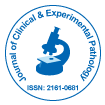Notre groupe organise plus de 3 000 séries de conférences Événements chaque année aux États-Unis, en Europe et en Europe. Asie avec le soutien de 1 000 autres Sociétés scientifiques et publie plus de 700 Open Access Revues qui contiennent plus de 50 000 personnalités éminentes, des scientifiques réputés en tant que membres du comité de rédaction.
Les revues en libre accès gagnent plus de lecteurs et de citations
700 revues et 15 000 000 de lecteurs Chaque revue attire plus de 25 000 lecteurs
Indexé dans
- Index Copernic
- Google Scholar
- Sherpa Roméo
- Ouvrir la porte J
- JournalSeek de génamique
- JournalTOC
- Annuaire des périodiques d'Ulrich
- Recherche de référence
- Université Hamdard
- EBSCO AZ
- OCLC-WorldCat
- Publons
- Fondation genevoise pour l'enseignement et la recherche médicale
- Euro Pub
- ICMJE
Liens utiles
Revues en libre accès
Partager cette page
Abstrait
Histopathological and Biochemical Assessment of Chronic Oral Administration of Aqueous Leaf Extract of Thymus Serrulatus in Mice
Nigatu Debelo, Mekbib Afework, Asfaw Debella, Eyasu Makonnen, Wondwossen Ergete and Bekesho Geleta
Background: Medicinal plants are the source of treatment for many diseases throughout the developing world. The provision of safe herbal therapies could, thus, become a critical tool to increase access to health care in minimizing the undesirable effects. Thymus serrulatus is among commonly used herbal remedy in Ethiopia in addition to its use for spicing a food and as infusion in tea. This study was designed to investigate toxic effects of the aqueous leaf extract of Thymus serrulatus in mice.
Methods: In this study, the mice were randomly divided into control and treatment groups that received distilled water and oral administration of single dose of 300, 2000, 5000 and 10,000 mg/kg (n=5) extract for acute toxicity, respectively and followed for 14 days. The chronic toxicity was evaluated through daily oral administration of extracts at doses of 200 and 600 mg/kg for 90 days in mice (n=6). On the 91st day, blood samples were collected for hematological and biochemical analysis. Liver and kidney were harvested for histopathological examination by tissue section preparation and microscopic examination.
Results: The acute toxicity study found no signs of toxicity; hence LD50 was greater than 10,000 mg/kg. After 90 days of extract administration, there was no significant change in body weight, and most of the evaluated hematological and biochemical parameters. There was a significant decrease in count of basophils in male mice treated at dose 600 mg/kg. In addition, creatinine level of female mice at both doses was also significantly reduced. No death was recorded, and body weight change remained normal compared to the control. In gross observations, the kidneys and liver appear normal compared to the control. Histopathological examination of liver and kidney were essentially normal.
Conclusions: Thymus serrulatus is relatively safe. However, mild mononuclear leukocytic infiltration was observed in mice treated at higher doses.
Revues par sujet
- Agriculture et Aquaculture
- Biochimie
- Chimie
- Food & Nutrition
- Génétique et biologie moléculaire
- Géologie et sciences de la Terre
- Immunologie et microbiologie
- Ingénierie
- La science des matériaux
- Le physique
- Science générale
- Sciences cliniques
- Sciences environnementales
- Sciences médicales
- Sciences pharmaceutiques
- Sciences sociales et politiques
- Sciences vétérinaires
- Soins infirmiers et soins de santé
Revues cliniques et médicales
- Allaitement
- Anesthésiologie
- Biologie moléculaire
- Cardiologie
- Chirurgie
- Dentisterie
- Dermatologie
- Diabète et endocrinologie
- Gastro-entérologie
- Immunologie
- La génétique
- Maladies infectieuses
- Médecine
- Microbiologie
- Neurologie
- Oncologie
- Ophtalmologie
- Pédiatrie
- Recherche clinique
- Soins de santé
- Toxicologie

 English
English  Spanish
Spanish  Chinese
Chinese  Russian
Russian  German
German  Japanese
Japanese  Portuguese
Portuguese  Hindi
Hindi